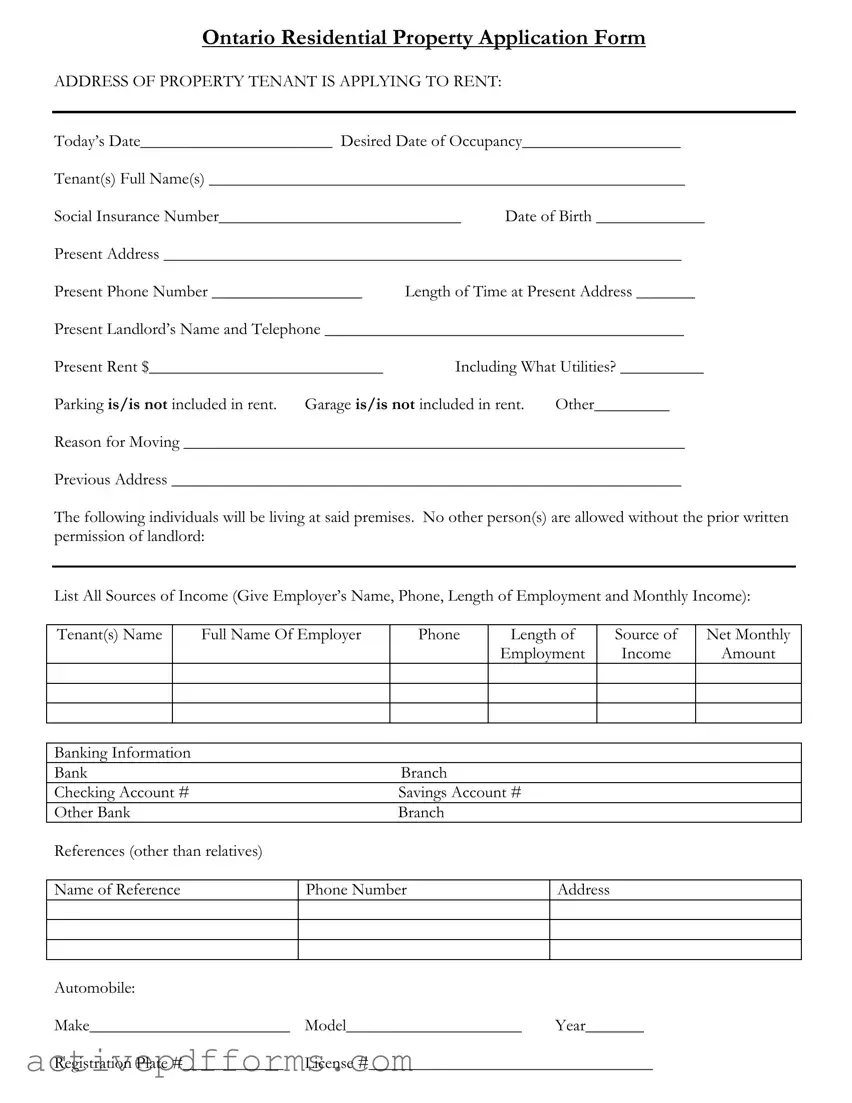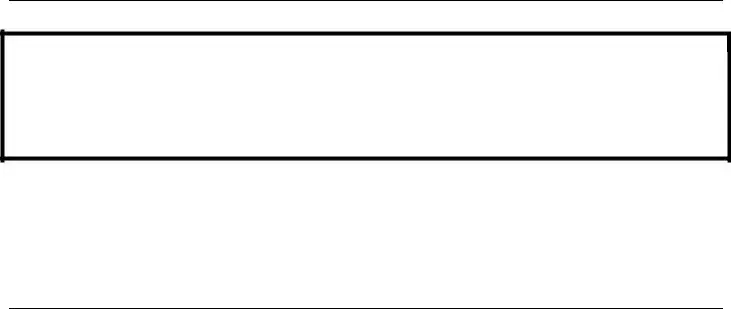Ontario Residential Property Application Form
ADDRESS OF PROPERTY TENANT IS APPLYING TO RENT:
Today’s Date_______________________ Desired Date of Occupancy___________________
Tenant(s) Full Name(s) _________________________________________________________
Social Insurance Number_____________________________ Date of Birth _____________
Present Address ______________________________________________________________
Present Phone Number __________________ Length of Time at Present Address _______
Present Landlord’s Name and Telephone ___________________________________________
|
|
|
|
Present Rent $____________________________ |
Including What Utilities? __________ |
Parking is/is not included in rent. |
Garage is/is not included in rent. |
Other_________ |
Reason for Moving ____________________________________________________________
Previous Address _____________________________________________________________
The following individuals will be living at said premises. No other person(s) are allowed without the prior written permission of landlord:
List All Sources of Income (Give Employer’s Name, Phone, Length of Employment and Monthly Income):
Tenant(s) Name |
|
Full Name Of Employer |
Phone |
Length of |
|
Source of |
Net Monthly |
|
|
|
|
|
Employment |
|
Income |
Amount |
|
|
|
|
|
|
|
|
|
|
|
|
|
|
|
|
|
|
|
|
|
|
|
|
|
|
|
|
|
|
|
|
|
|
|
|
|
|
|
Banking Information |
|
|
|
|
|
|
|
|
Bank |
|
|
Branch |
|
|
|
|
|
Checking Account # |
|
|
Savings Account # |
|
|
|
|
Other Bank |
|
|
Branch |
|
|
|
|
|
References (other than relatives) |
|
|
|
|
|
|
|
|
|
|
|
|
|
|
Name of Reference |
|
Phone Number |
|
Address |
|
|
|
|
|
|
|
|
|
|
|
|
|
|
|
|
|
|
|
|
|
|
|
|
|
|
|
|
|
Automobile: |
|
|
|
|
|
|
|
|
Make________________________ |
Model_____________________ |
Year_______ |
|
Registration Plate #____________ |
License #__________________________________ |
|
In Case of Emergency, Notify: |
|
Name: __________________________ |
Relationship ___________________________ |
Address: __________________________________________________________________
Phone: ________________________________
Deposit of $ ________________ was paid on the _________ day of ____________________ Said Deposit was Paid
by:
_____________________________________________________ Cheque/cash/money order This deposit is
applicable to first month's rent subject to landlord's approval of this application.
Balance of $_____________ will be paid as follows: _________________________________
I [We] hereby apply for rental [lease] of the residential premises as indicated on page one of this application form. I [We] give the landlord [landlord's agent, representative, property management] permission to check my credit history, references and other relevant investigation to determine my residential rental history, court, financial history and my ability to pay rent and maintain the rental unit and rental premises. My signature below, confirms that agree to and I request all credit reporting services, banks, court, tribunals, employers, and personal references to disclose any pertinent information about me.
I [We] clearly understand and agree as evidenced by my [our] signature below that this is an application to rent [lease] and in no way includes an agreement between landlord and tenant to rent [lease]. I [We] understand and agree that a tenancy agreement or lease will be entered into at the discretion of the landlord.
In the event that the landlord accepts this [my/our] application I understand that full payment of first and last month's rent is required prior to the key of said rental unit [rental premises] be delivered to me [us].
I further understand and agree that in the event that the landlord accepts this [my/our] application, once the landlord accepts, a binding offer to rent [lease] said rental unit [premises] is created and if I withdraw or cancel this [my/our] application any and all deposit paid will not be refunded. Landlord will apply said deposit to re-advertisement cost to find a new tenant, administration cost to process a new tenant's application, and loss any loss of income as a result of such cancellation and all other expenses incurred.
If accepted, I agree to sign a lease and or written tenancy agreement.
In the event that the landlord does not accept this [my/our] application, I understand that reasons for refusal may not be divulged but my deposit will be refunded in full.
I have inspected the rental property and hereby confirm that said rental unit [premises] is in acceptable condition as of the date of this tenant application form.
Date:_________________________________ |
Applicant’s Signature___________________________ |
Date:_________________________________ |
Applicant’s Signature___________________________ |
Landlord’s Source Centre Telephone: 416-964-1607 or 1-800-427-5973 Facsimile: 416-964-1757 or 1-800-627-7725


